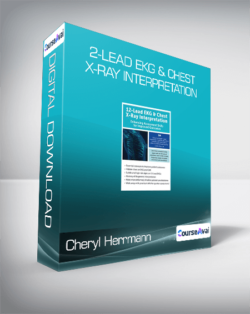Yet, it provides us with so much more information that can help improve patient care. The purpose of this portion of the recording is to assist the health care professional in mastering 12-lead EKG assessment skills in order to identify the common and not-so-common changes.Purchase Cheryl Herrmann – 12-Lead EKG & Chest X-Ray Interpretation courses at here with PRICE $219 $60 Cheryl Herrmann – 12-Lead EKG & Chest X-Ray InterpretationPART I: THE ABCS OF 12-LEAD EKG INTERPRETATION12-Lead EKG 101Cardiac electrical conduction systemElectrical vectorsIntroduction to the 12-leadsLimb leadsAugmented leadsChest leadsNormal polarity and P-QRS-T configuration of each leadAce the AxisLeft and right axis deviationCauses and criteria of axis deviationMethods to determine axis deviationCase presentations, analysis, and clinical applicationBeat the BundlesRight and left bundle branch blocks (BBB)Criteria for right vs. left BBBCauses and complications of right and left BBBLeft anterior and left posterior hemiblocksCase presentations, analysis, and clinical applicationCorrelate the Coronary AnatomyCoronary arteriesRight coronary artery (RCA)Left coronary artery (LCA)Left anterior descending artery (LAD)Circumflex artery (CX)Posterior descending artery (PDA)Left ventricular wallsInferiorAnteriorSeptalLateralPosteriorRelationship of coronary arteries and ventricular walls to the 12-leadsInferior—RCA—leads II, III, AVFAnterior/septal—LAD—leads V1-V4Lateral—circumflex—leads I, AVL, V5, V6Posterior—PDA—reciprocal changes V1-V4Differential Diagnosis: 12-Lead EKG in Acute Coronary SyndromeIschemia patternInjury patternInfarction patternReciprocal changesST segment elevation myocardial infarction (STEMI)Non-ST segment elevation myocardial infarction (NSTEMI)Coronary spasmTakotsubo cardiomyopathy (broken heart syndrome)Example and Analysis Time – Piecing It All Together30-second diagnosis of STEMI on 12-lead EKGCoronary angiographic correlation to 12-lead EKGCase presentations, analysis, and clinical applicationAdvanced 12-Lead: Challenging Clinical PresentationsAtrial and ventricular hypertrophyWolff-Parkinson-White syndromeProlonged QT intervalsPART II: CHEST X-RAY INTERPRETATION – AS EASY AS BLACK AND WHITENote: Most chest X-ray examples will be AP filmsChest X-ray basicsTechniqueBlack and white principlesProjectionsAnterior-posterior (AP)Posterior-anterior (PA)LateralSystematic ApproachBone structuresIntercostal spacesSoft tissuesLungs/trachea/pulmonary vasculaturePleural surfacesDiaphragmMediastinumHeart and great vesselsInvasive linesAs Easy as BlackPneumothoraxSubcutaneous emphysemaClinical application and treatmentAs Easy as WhitePleural effusionPulmonary edemaPneumoniaAtelectasisAcute respiratory distress syndrome (ARDS)CardiomyopathyPericardial effusionCardiac tamponadeClinical application and treatmentBeyond the BasicsGet Cheryl Herrmann – 12-Lead EKG & Chest X-Ray Interpretation downloadAortic aneurysmPost-op changes with pneumonectomyHydropneumothoraxEsophagogastrectomyDextrocardiaClinical application and treatmentPART III: CXR & 12 LEAD EKG CASE PRESENTATIONS, ANALYSIS, AND CLINICAL APPLICATION Would you like to receive Cheryl Herrmann – 12-Lead EKG & Chest X-Ray Interpretation ?:When to be concerned — 12-Lead EKG Pearls of WisdomIn a cardiac event, the clock starts ticking as soon as the coronary artery becomes occluded. Are you ready to rapidly interpret STEMI (ST segment elevation myocardial infarction) changes with a 12-lead EKG and provide effective intervention to reduce the size of the AMI? The 12-lead EKG is one of the most frequently utilized cardiac assessment tools to assess chest pain. Yet, it provides us with so much more information that can help improve patient care. The purpose of this portion of the recording is to assist the health care professional in mastering 12-lead EKG assessment skills in order to identify the common and not-so-common changes. You will also examine subtle and high-risk signs on 12-Lead EKG that are of concern preoperatively, in the ED, or in the clinic.As Easy as Black and White…Chest X-rays are also a commonly ordered diagnostic test, yet viewing and interpreting them can be challenging. Chest X-rays can be as simple as black and white. The purpose of this portion of the recording is to provide clinicians with chest X-ray interpretation skills in order to help you easily assess changes in the patient’s condition. You will develop skills in line identification; differentiations among atelectasis, pneumonia, ARDS, pleural effusion, and pulmonary edema; and identification of pneumothorax, cardiac tamponade, and cardiomyopathy. You will view examples of numerous chest X-rays to reinforce the concepts presented. Clinicians will walk away from this session with practical skills for better, quicker patient assessment allowing for more effective intervention.Get Cheryl Herrmann – 12-Lead EKG & Chest X-Ray Interpretation downloadPurchase Cheryl Herrmann – 12-Lead EKG & Chest X-Ray Interpretation courses at here with PRICE $219 $60
 Katy Bowman – Whole Body Biomechanics – ALL THREE COURSES
₹8,632.00
Katy Bowman – Whole Body Biomechanics – ALL THREE COURSES
₹8,632.00
 Pharmacology of Infectious Diseases & Immunizations for Advanced Practice Clinicians – Eric Wombwell
₹9,960.00
Pharmacology of Infectious Diseases & Immunizations for Advanced Practice Clinicians – Eric Wombwell
₹9,960.00
Cheryl Herrmann – 12-Lead EKG & Chest X-Ray Interpretation
₹9,960.00






